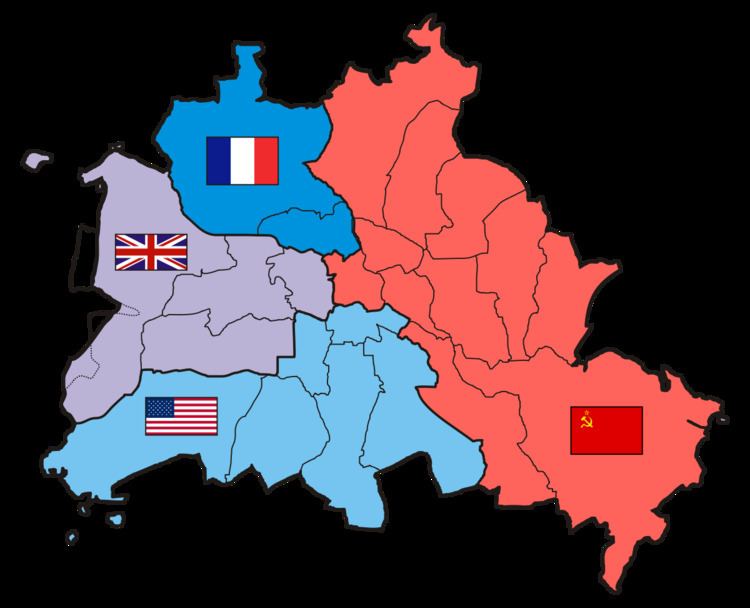Country Germany Founded 1945 Replaced by Bundesliga | State Berlin Folded 1963 (18 seasons) Level on pyramid Level 1 | |
 | ||
The Oberliga Berlin (English: Premier league Berlin), sometimes also referred to as Stadtliga Berlin (English: City league Berlin) or Vertragsliga Berlin (English: Contract league Berlin) was the highest level of the German football league system in the city of West Berlin in Germany from 1945 until the formation of the Bundesliga in 1963. It was by far the smallest of the five Oberligas.
Contents
Overview
The league was created in 1945, incorporating clubs from all four sectors of the allied-occupied Berlin. It replaced the Gauliga Berlin-Brandenburg as the highest league in the region. In its first year, it was staged in four groups with the winner of each group taking part in a finals tournament. In 1946, three clubs from each of those four groups went to form the single-division, twelve team, Oberliga Berlin. Alongside the Oberliga Berlin, four other Oberligas were formed in Germany in those years:
The clubs in Berlin were originally not permitted to carry their pre-war names and had to be simply named after the suburb they represented. This rule was slowly lifted in the three western sectors and by 1948, clubs in what was to become West-Berlin carried their original names again. In the Soviet sector, the future East Berlin, clubs took up names in accordance with the requirements of the new Communist regime.
With the reintroduction of the German championship in 1948, the winner of the Oberliga Berlin went on to the finals tournament with the other Oberliga champions. Being the smallest of the five Oberligas it is not surprising that no club from Berlin won a German championship in these years or even reached the final.
After the 1949-50 season, the clubs from East Berlin left the unified Berlin league system and joined the East German leagues instead. [[1. FC Union Berlin|Union Oberschöneweide, qualified for the German championship finals in 1950, was not permitted to participate in this tournament either. The Oberliga Berlin carried on with clubs from West Berlin only.
Below the Oberliga Berlin ranked the Amateurliga Berlin as a second tier. Originally staged in a varying number of groups, it became a single-group competition from 1950.
With the construction of the Berlin Wall in 1961 the clubs in West Berlin suffered a substantial loss of revenue because they were cut off from supporters in the Eastern part of the city, causing the Oberliga clubs to suffer financially. Novelty ideas were floated to combat the problem, like, instead of players receiving the maximum legal wage for a footballer in West Germany's top tier at the time, DM 400 per month, the players should only be paid for results, meaning they would not receive any money for games the club lost.
In 1963, after 18 seasons, the Oberliga Berlin was disbanded in favor of the new Bundesliga. The champion of the 1962-63 season, Hertha BSC Berlin, was admitted to the new Bundesliga.
Reforming of the Oberliga Berlin
In 1974, with the disbanding of the Regionalliga Berlin, the Oberliga Berlin was re-created, now as the third tier of German football. This was not the formation of a new league, but the renaming of the Amateurliga Berlin to Oberliga Berlin.
Founding members of the Oberliga Berlin
The following clubs took part in the first proper season of the Oberliga in 1946–47. The names in brackets are the ones they carried in this season:
Disbanding of the Oberliga
With the introduction of the new Bundesliga, the Oberligas were disbanded. The top team of the Oberliga Berlin was admitted to the Bundesliga, the clubs placed second to eight went to the Regionalliga Berlin, one of the five new second divisions. The bottom two teams were relegated to the Amateurliga Berlin while the top three from the Amateurliga were promoted.
Admitted to Bundesliga:
The following teams from the Oberliga went to the new Regionalliga:
Relegated to the Amateurliga:
Qualifying for the Bundesliga
The qualifying system for the new league was fairly complex. The league placings of the clubs playing in the Oberligen for the last ten seasons were taken into consideration, whereby results from 1952 to 1955 counted once, results from 1955 to 1959 counted double and results from 1959 to 1963 triple. A first-place finish was awarded 16 points, a sixteenth place one point. Appearances in the German championship or DFB-Pokal finals were also rewarded with points. The five Oberliga champions of the 1962-63 season were granted direct access to the Bundesliga. All up, 46 clubs applied for the 16 available Bundesliga slots.
Following this system, by 11 January 1963, the DFB announced nine fixed clubs for the new league and reduced the clubs eligible for the remaining seven places to 20. Clubs within the same Oberliga that were separated by less than 50 points were considered on equal rank and the 1962-63 placing was used to determine the qualified team.
From this league, only three clubs applied for the one available spot, Hertha BSC Berlin qualified early.
Points table:
Honours
The winners and runners-up of the Oberliga Berlin:
Placings & all-time table of the Oberliga Berlin
The final placings and all-time table of the Oberliga Berlin:
Source: "Oberliga Berlin". Das deutsche Fussball-Archiv. Retrieved 2008-01-10.
Source: "All-time table of the Oberligas". Clas Glenning. Archived from the original on 2009-07-31. Retrieved 2008-01-10.
